A sleeping surface designed specifically for babies and young children, intended for use within a crib or similar enclosure, is crucial for their development. These surfaces are typically firmer than those intended for older individuals, a design consideration predicated on safety guidelines. The dimensions are standardized to fit securely within standard crib frames, minimizing the risk of entrapment. Materials used are often hypoallergenic and easy to clean, acknowledging the unique needs of this age group.
Optimal rest is foundational for healthy growth and cognitive development during infancy. A secure and appropriate surface contributes significantly to this rest, promoting safer sleep practices and reducing the risk of Sudden Infant Death Syndrome (SIDS). The development of safer sleep environments has been a focus of pediatric health organizations for decades, leading to specific recommendations regarding firmness, breathability, and the absence of loose bedding. This progress has led to significant advancements in manufacturing and material science, resulting in products designed for a baby’s well-being.
This overview lays the foundation for a more detailed examination of material composition, safety standards, sizing considerations, and care instructions related to these essential items. Further discussion will address how to select an appropriate product based on individual needs and budget, while remaining compliant with current safety recommendations.
Important Considerations for Selecting Infant Bedding
Choosing appropriate bedding for an infant is a crucial decision that impacts safety and comfort. Adherence to recommended guidelines is essential to minimize risks.
Tip 1: Firmness is Paramount: Select a firm sleep surface. A soft surface can conform to the infant’s face, increasing the risk of suffocation. Pediatric guidelines universally recommend a firm foundation for infant sleep.
Tip 2: Ensure Proper Fit: Verify that the product fits snugly within the crib frame. Gaps between the sides of the crib and the bedding can pose an entrapment hazard. Measure the interior dimensions of the crib before purchase.
Tip 3: Prioritize Breathable Materials: Opt for materials that promote airflow. Breathable fabrics can help reduce the risk of overheating and improve ventilation around the infant. Look for products specifically designed with breathable construction.
Tip 4: Consider Hypoallergenic Properties: Infants are particularly susceptible to allergies. Select materials that are hypoallergenic and resistant to dust mites. Regular cleaning of the sleep surface is also advisable.
Tip 5: Adhere to Safety Standards: Confirm that the product meets or exceeds current safety standards established by regulatory agencies. Certifications from recognized testing organizations provide assurance of safety compliance.
Tip 6: Limit Additional Bedding: Avoid placing loose blankets, pillows, or stuffed animals within the crib. These items increase the risk of suffocation and entanglement. A fitted sheet is the only bedding item recommended.
Tip 7: Regularly Inspect for Wear and Tear: Routinely examine the bedding for signs of damage, such as rips, tears, or loose seams. Replace the item immediately if any damage is detected. Compromised bedding can present a safety hazard.
Prioritizing firmness, fit, breathability, and adherence to safety standards is fundamental when choosing the correct surface. These factors contribute directly to a safer sleep environment for the infant.
The next section will address specific material types and cleaning recommendations, providing further guidance on maintaining a safe and hygienic sleep environment.
1. Firmness Consistency
Firmness consistency in the context of bedding for infants is a critical safety parameter, directly influencing the risk of Sudden Infant Death Syndrome (SIDS) and suffocation. The selection of a product with consistent firmness across its entire surface is paramount for infant well-being.
- Surface Uniformity and Support
Surface uniformity dictates that the product should offer consistent support across all areas. Inconsistent firmness can create indentations or pockets where an infant’s face could become entrapped, obstructing airways. A properly designed product will resist compression, maintaining a flat, even plane. Examples include mattresses engineered with high-density foam or innerspring systems calibrated for uniform pressure distribution.
- Material Density and Composition
The density and composition of materials directly influence firmness. High-density materials, such as certain types of foam or tightly coiled springs, contribute to a firmer sleep surface. Manufacturers must specify and maintain strict quality control over these materials to ensure consistency from batch to batch. Deviations in density or composition can lead to localized soft spots, compromising the overall safety profile.
- Impact of Temperature and Humidity
Environmental factors like temperature and humidity can affect the firmness of certain materials. Some foams may soften slightly in warmer conditions, potentially reducing the firmness. Manufacturers should conduct testing under a range of environmental conditions to assess and mitigate these effects. Products designed for various climates should maintain consistent firmness levels despite temperature and humidity fluctuations. The impact can be minimized through the utilization of materials with stable physical properties.
- Long-Term Durability and Compression Resistance
Over time, bedding can experience compression and degradation, leading to a reduction in firmness. It is essential that the product maintains its firmness characteristics throughout its expected lifespan. Look for items with rigorous testing and warranty claims that supports long-term performance. Regular inspection for sagging or indentations is also recommended, as these indicators signal a potential compromise in safety.
These facets of firmness consistency highlight its importance in safe infant bedding. Each aspect contributes to a safe and reliable sleep environment. By adhering to stringent manufacturing standards and utilizing durable, tested materials, risks can be minimized, promoting infant safety. The selection of a bedding surface with demonstrated firmness consistency is crucial for ensuring a healthy and secure sleep environment for infants.
2. Precise Dimensions
Precise dimensions are not merely a manufacturing specification for infant bedding; they are a critical safety parameter. Deviations from established dimensions can compromise the integrity of the sleep environment, increasing the risk of injury or, in extreme cases, fatality. The following points i
llustrate the imperative of adhering to precise dimensional standards.
- Elimination of Entrapment Hazards
The primary function of precise dimensions is to eliminate gaps between the bedding and the crib frame. Even seemingly small gaps can create entrapment hazards where an infant’s limbs, head, or torso can become lodged, leading to injury, suffocation, or death. Regulatory bodies and manufacturers adhere to strict dimensional tolerances to mitigate this risk. Examples include bedding designed with corner seams that precisely align with the crib frame’s interior dimensions, leaving no room for movement or slippage.
- Ensuring a Secure Fit of Fitted Sheets
Dimensional accuracy extends to fitted sheets designed for use with infant bedding. A fitted sheet that is too small will be difficult to secure properly, increasing the likelihood of it detaching during sleep and posing a suffocation hazard. Conversely, a fitted sheet that is too large may bunch or fold, creating uneven surfaces that can be uncomfortable or hazardous. Precise dimensions ensure a snug and secure fit, maintaining a flat and stable sleep surface.
- Compatibility with Standard Crib Sizes
Crib dimensions are subject to regulatory standards, and infant bedding is manufactured to conform to these standards. Precise dimensions ensure compatibility across different crib brands and models. This standardization allows consumers to confidently select bedding knowing that it will fit securely within their crib. Deviation from these standards can result in incompatibility, requiring the purchase of specialized or custom-sized bedding, which may not adhere to the same safety regulations.
- Impact on Product Performance and Longevity
Dimensional accuracy also affects the long-term performance and longevity of infant bedding. Products that are consistently exposed to stress due to improper fit may degrade more quickly, leading to a loss of firmness or structural integrity. Precise dimensions ensure that the bedding functions as intended throughout its lifespan, maintaining a safe and comfortable sleep environment for the infant.
In conclusion, the adherence to precise dimensions in the manufacturing of infant bedding is not merely a matter of convenience or aesthetic appeal; it is a fundamental safety requirement. By ensuring proper fit, eliminating entrapment hazards, and promoting compatibility with standard crib sizes, precise dimensions contribute significantly to the creation of a safe and secure sleep environment for infants. The failure to prioritize dimensional accuracy can have severe and potentially fatal consequences.
3. Material Safety
Material safety is a foundational element in the design and manufacture of infant bed mattresses. The direct and prolonged contact infants have with their sleeping surface necessitates stringent controls over the composition of materials used. Potential hazards arise from the inclusion of volatile organic compounds (VOCs), flame retardants, phthalates, and heavy metals, all of which can leach from the mattress and be ingested, inhaled, or absorbed through the skin. The physiological vulnerability of infants makes them particularly susceptible to adverse health effects, including respiratory irritation, endocrine disruption, and developmental delays. For instance, the presence of certain flame retardants, historically used to meet flammability standards, has been linked to neurodevelopmental issues. Consequently, the selection of inherently flame-resistant materials or the use of less hazardous alternatives is crucial.
The importance of material safety manifests practically in the certifications sought by responsible manufacturers. Certifications such as GREENGUARD Gold indicate that a mattress has undergone rigorous testing for chemical emissions, ensuring that VOC levels are below established thresholds deemed safe for sensitive populations. Similarly, Oeko-Tex Standard 100 certification verifies that textile components have been tested for harmful substances. The use of organic cotton, natural latex, and plant-based foams further mitigates the risk of exposure to synthetic chemicals. Real-life examples underscore the significance of these precautions. Cases of infants experiencing skin rashes or respiratory problems traced back to chemically treated mattresses highlight the tangible consequences of inadequate material safety standards. The practical significance of understanding this connection lies in empowering consumers to make informed purchasing decisions, prioritizing products that demonstrably minimize the risk of chemical exposure to their infants.
In summary, material safety is not merely an ancillary consideration but a central determinant of the health and safety profile of any infant bed mattress. The challenges in ensuring material safety lie in the complexity of supply chains, the ongoing research into potential health effects of various chemicals, and the need for continuous innovation in material science. Future advancements must prioritize the development of inherently safe and sustainable materials, further reducing the potential for chemical exposure and promoting a healthier sleep environment for infants. Broader themes of environmental responsibility and consumer awareness converge in the realm of infant bedding, necessitating ongoing collaboration between manufacturers, regulatory bodies, and healthcare professionals to safeguard infant health.
4. Breathability Performance
Breathability performance in infant bed mattresses is a critical safety and comfort parameter. It directly influences the dissipation of heat and moisture, mitigating risks associated with overheating and promoting a more regulated sleep environment for the infant.
- Airflow Dynamics and Material Selection
The ability of an infant bed mattress to facilitate airflow is intrinsically linked to the materials used in its construction. Open-cell foam structures, for instance, allow for greater air circulation compared to closed-cell foams. Natural fibers like cotton and wool also exhibit superior breathability compared to synthetic materials. The selection of these materials directly impacts the mattress’s ability to dissipate heat generated by the infant’s body. Inadequate airflow can lead to a buildup of heat and moisture, increasing the risk of overheating, discomfort, and potential sleep disturbances.
- Moisture Wicking and Evaporation
An effective mattress wicks away moisture and promotes evaporation, creating a drier and more comfortable sleep surface. Infants are prone to sweating and drooling, and a mattress that retains moisture can become a breeding ground for bacteria and mold. Breathable materials facilitate the evaporation of this moisture, helping to maintain a hygienic sleep environment. Examples include mattresses incorporating fabrics treated with moisture-wicking technologies or featuring ventilated designs that enhance airflow around the infant’s body. Failure to address moisture accumulation can lead to skin irritation and an increased risk of respiratory issues.
- Reduction of Overheating Risk
Overheating is a significant risk factor for Sudden Infant Death Syndrome (SIDS). A breathable mattress helps to regulate the infant’s body temperature, reducing the risk of overheating during sleep. By facilitating th
e dissipation of heat, these mattresses create a more stable and comfortable thermal environment. Design features that promote airflow, such as perforated layers or channeled surfaces, contribute to this temperature regulation. In contrast, mattresses made with impermeable materials can trap heat, leading to potentially dangerous temperature elevations. - Impact of Mattress Cover Design
The mattress cover plays a significant role in breathability performance. Tightly woven covers, while offering protection against spills and stains, can restrict airflow. Breathable mattress covers are typically made from materials that allow air to permeate while still providing a barrier against liquids. Examples include covers made from organic cotton or bamboo fibers, which are naturally breathable and moisture-wicking. The design of the cover, including its thickness and weave, directly impacts the mattress’s overall breathability performance.
The interplay between airflow dynamics, moisture wicking capabilities, overheating risk reduction, and mattress cover design collectively determines the breathability performance of an infant bed mattress. Selecting a mattress with optimized breathability is crucial for promoting a safe, comfortable, and hygienic sleep environment, contributing directly to the well-being of the infant.
5. Cleanability
Cleanability is a paramount consideration in the context of infant bed mattresses, influencing hygiene, health, and the overall lifespan of the product. The capacity to effectively remove contaminants from the mattress surface is integral to maintaining a safe sleep environment for infants, who are particularly vulnerable to bacteria, allergens, and other irritants.
- Surface Material Properties and Liquid Resistance
The selection of surface materials significantly impacts cleanability. Materials exhibiting liquid resistance prevent fluids from penetrating the mattress core, mitigating the risk of bacterial growth and staining. Examples include mattresses with waterproof or water-resistant covers composed of vinyl or polyurethane. While these materials offer effective liquid barriers, breathability may be compromised, requiring careful consideration of the trade-offs. The efficacy of cleaning agents on these surfaces, and their potential for degradation upon repeated cleaning, also necessitate evaluation.
- Removable and Washable Covers
Mattresses featuring removable and washable covers offer a practical solution for maintaining cleanliness. The ability to detach and launder the cover allows for thorough removal of contaminants, extending the lifespan of the mattress and reducing the risk of allergen accumulation. Fabrics suitable for machine washing and drying, such as cotton or polyester blends, are commonly employed. However, the durability of the cover’s waterproofing properties after repeated washings should be assessed to ensure continued protection.
- Antimicrobial Treatments and Hygiene
Antimicrobial treatments can inhibit the growth of bacteria and fungi on the mattress surface, enhancing hygiene. These treatments, often involving the incorporation of silver ions or other antimicrobial agents into the mattress fibers, provide an additional layer of protection against microbial proliferation. However, the long-term efficacy and potential health effects of these treatments require consideration. The impact of cleaning agents on the antimicrobial properties should also be evaluated to ensure continued effectiveness.
- Seam Construction and Contamination Prevention
Seam construction plays a critical role in preventing contaminant penetration. Tightly sealed seams minimize the risk of fluids seeping into the mattress core, where they can be difficult to remove and promote bacterial growth. Welded seams or sealed zippers offer superior protection compared to loosely stitched seams. The integrity of the seam construction should be evaluated over time to ensure continued effectiveness in preventing contamination. Practical examples of such would be welded seams on mattress covers and tightly-sealed zipper encasements.
The integration of these cleanability features directly influences the hygiene and longevity of infant bed mattresses. The selection of appropriate materials, removable covers, antimicrobial treatments, and robust seam construction collectively contribute to a cleaner and safer sleep environment. Regular cleaning and maintenance, coupled with the incorporation of these design elements, are essential for mitigating the risks associated with contamination and promoting infant health.
Frequently Asked Questions
The following addresses common inquiries and concerns regarding the selection, use, and maintenance of infant bed mattresses. The information presented aims to provide clarity and guidance to ensure a safe and healthy sleep environment.
Question 1: What level of firmness is optimal for an infant bed mattress?
The recommended firmness is a high level of firmness. A soft mattress surface can increase the risk of suffocation. The surface should be sufficiently firm to prevent indentation when the infant is placed upon it.
Question 2: How often should an infant bed mattress be cleaned?
Routine cleaning is advised. The mattress should be cleaned immediately following any soiling and at regular intervals, such as monthly, to prevent the accumulation of allergens and bacteria.
Question 3: Are there specific materials to avoid when selecting an infant bed mattress?
Materials containing known allergens, such as certain latex formulations for latex-sensitive individuals, and those treated with potentially harmful chemicals should be avoided. Prioritize mattresses with certifications indicating low VOC emissions.
Question 4: How can the fit of an infant bed mattress within a crib be verified?
Measure the interior dimensions of the crib and compare them to the stated dimensions of the mattress. There should be minimal to no gap between the mattress edge and the crib frame to prevent entrapment.
Question 5: What is the expected lifespan of an infant bed mattress?
The lifespan depends on construction quality and usage. However, it is generally recommended to replace an infant bed mattress after a few years or if any signs of wear, damage, or loss of firmness are observed.
Question 6: Is a used infant bed mattress a safe option?
The use of a previously owned mattress is generally discouraged. It may have compromised firmness, harbor allergens, or lack a known history of use and maintenance. New mattresses meeting current safety standards are generally preferrable.
These FAQs address critical aspects of infant bed mattress selection and care. The information provided underscores the importance of prioritizing safety and hygiene to promote infant well-being.
The subsequent section will provide guidance on identifying reputable mattress brands and assessing product certifications.
Concluding Remarks on Infant Bed Mattresses
This discourse has explored the critical attributes of the “infant bed mattress,” emphasizing firmness, precise dimensions, material safety, breathability, and cleanability. Each characteristic contributes significantly to creating a safe and supportive sleep environment, directly impacting infant well-being and minimizing potential hazards. The information presented undersco
res the necessity of informed decision-making when selecting these essential products.
Given the direct and prolonged contact infants have with their bedding, ongoing vigilance is required. Manufacturers must maintain stringent quality control, and caregivers must remain proactive in ensuring adherence to safety guidelines and proper maintenance practices. Prioritizing the principles outlined in this exploration represents a tangible investment in the health and safety of future generations.


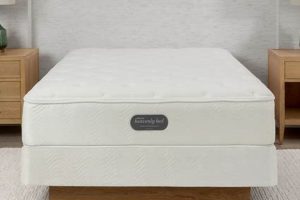
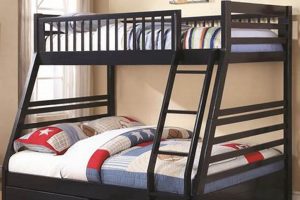
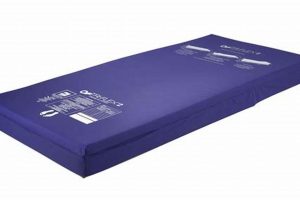
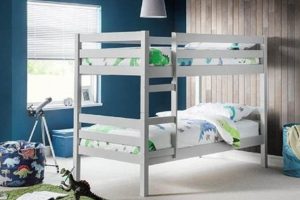
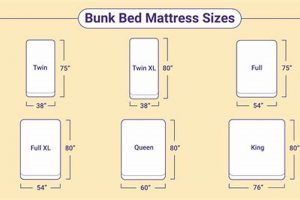
![Best Simmons Bunk Bed Mattress [Guide] for Kids Sleep Organic & Natural Mattress Buyer’s Guide: Non-Toxic Sleep Solutions Best Simmons Bunk Bed Mattress [Guide] for Kids Sleep | Organic & Natural Mattress Buyer’s Guide: Non-Toxic Sleep Solutions](https://mattressworldpa.com/wp-content/uploads/2025/07/th-7078-300x200.jpg)